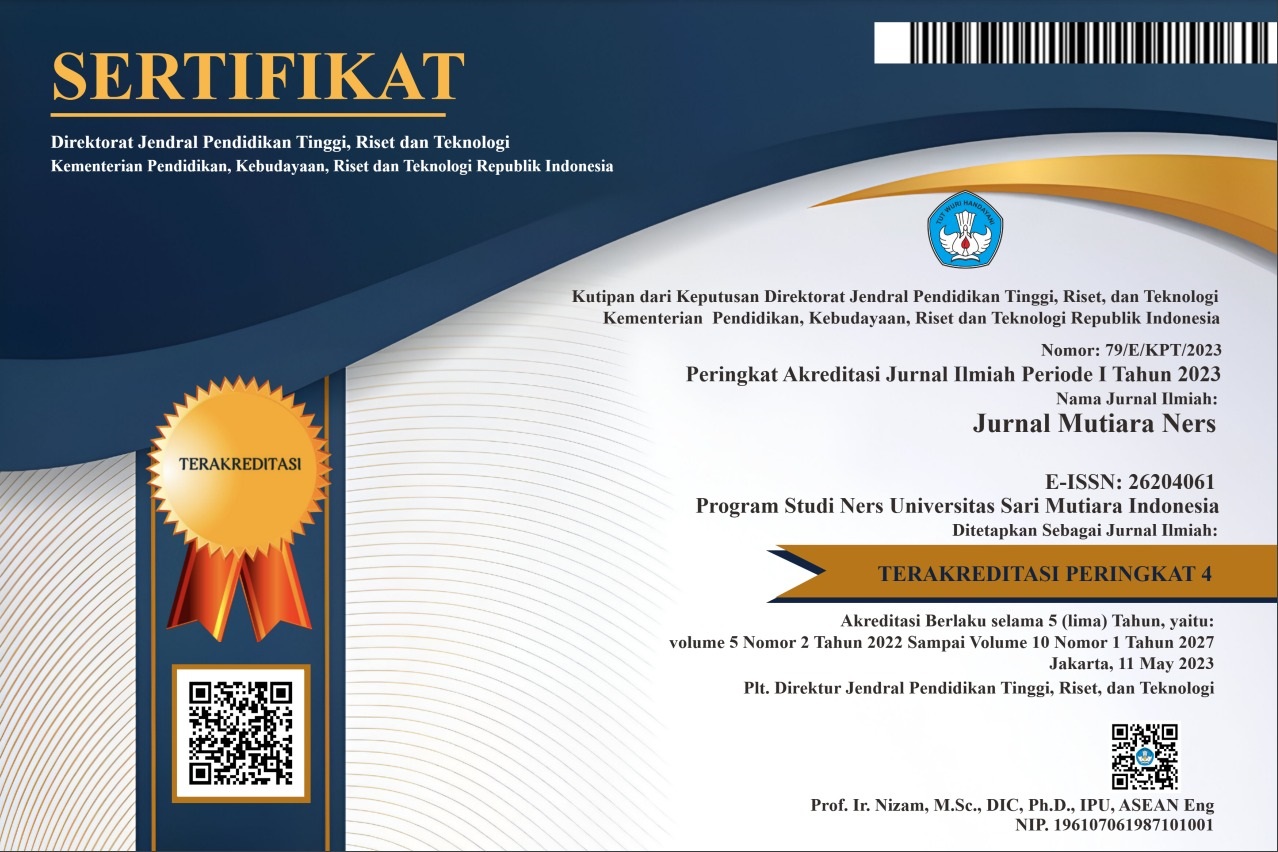EFFECTIVENESS OF TANDEM EXERCISE ON RISK OF FALL AMONG OLDER PEOPLE
Keywords:
Tandem Exercise, Fall Risk, Older PeopleAbstract
The older people population in Indonesia is predicted to continue to increase over the year. Increasing the number of older people will be a challenge for all. Older people might have decreased in the physiological body, especially in balance control such as changes in posture, changes in muscle strength, and visual decline. Balance disorder will increase the risk of falls caused and may result in the elderly being more susceptible to various diseases. Balance exercise such as Tandem Exercise is one way to reduce risk of fall. This research aimed to find out the effect of Tandem exercises on the risk of falling on the older people in Yogyakarta. This research was a Quasy Experimental study With Non-Equivalent Control Group Research Design. Samples of this study were 36 older people trough purposive sampling technique and divided into two groups. Group 1 was given 15 minutes Tandem exercise, every day in two weeks. Group 2 was a control group. The risk of fall was measured by The Time Up and Go Test. This study found that mean score of group 1 was decrease after intervention. This study also found that there was no significant different mean score of fall risk between two groups before intervention (p>0,05), meanwhile there was a significant different mean score after intervention (p<0,05). A significant different on risk of fall score before and after intervention also found in group 1 (p<0,05). In conclusion, health care provider should facilitate older people to participate in balance exercise such as Tandem exercise actively to decrease fall risk among older people.
Downloads
References
Anggraini, D., Zulpahiyana, & Mulyanti. (2015). Faktor Dominan Lansia Aktif Mengikuti Kegiatan Posyandu di Dusun Ngentak. Jnki, 3(3), 150–155.
Dwi Prabowo, S., Imram Radne Rimba, P., & Nindita Kumalawati, S. (2020). HUBUNGAN DUKUNGAN SOSIAL DENGAN RISIKO JATUH PADA LANSIA DI DESA NGADAEM REMBANG JAWA TENGAH [Universitas Alma Ata]. http://elibrary.almaata.ac.id/id/eprint/2156
Frederic, L., & Al Haris, M. (2022). Pengaruh Latihan Keseimbangan Terhadap Penurunan Risiko Jatuh Pada Lansia Di Desa Penen Kec. Sibiru-Biru. 901–906. https://journals.stimsukmamedan.ac.id/index.php/senashtek
Kurniawan, A. B. (2014). Hubungan Pengetahuan dan Perilaku Keluarga dengan Resiko Jatuh pada Lansia di Desa Pondok Karanganom Klaten.
Muladi, A. (2022). Pengaruh Balance Exercise Terhadap Tingkat Keseimbangan Postural Dalam Menurunkan Resiko Jatuh Pada Lansia. Intan Husada : Jurnal Ilmiah Keperawatan, 10(02), 145–154. https://doi.org/10.52236/ih.v10i2.248
Nuraini, K., Haryanto, J., & Fauzingtyas, R. (2017). Analisis Faktor Determinan Penyebab Jatuh pada Lansia dengan Diabetes Mellitus di Wilayah Kerja Puskesmas Bantul 1 Yogyakarta. Jurnal Keperawatan Respati Yogyakarta, 4(2), 171–178.
Padila. (2013). Buku ajar Keperawatan Gerontik. Nusa Medika.
PN, N. (2014). Latihan Jalan Tandem Lebih Baik Daripada Latihan Dengan Menggunakan Swiss Ball Terhadap Peningkatan Keseimbangan Untuk Mengurangi Resiko Jatuh Pada Lanjut Usia. Jurnal Fisioterapi, 14, 87–96.
Rahmadani, C. P. K. (2016). Pengaruh Latihan Jalan Tandem (Tandem Stance) Terhadap Keseimbangan untuk Mengurangi Risiko Jatuh pada Lanjut Usia.
Santoso, N. K., Thongpat, S., & Wattanakul, B. (2015). Predictors of Physical Activity in Older People With Hypertension, Bantul, Indonesia. J Health Res , 29, 7–13. https://doi.org/10.14456/jhr.2015.43
Sari, Y. P. (2015). Hubungan Tingkat Kemandirian Aktivitas Sehari-Hari Dengan Risiko Jatuh Pada Lansia Di BPSTW Unit Budhi Luhur Kasongan Bantul Yogyakarta.
Setyawan, M. B. (2018). Hubungan Frekuensi Senam Lansia Dengan Tingkat Risiko Jatuh Pada Usia Lanjut Di Balai Pelayanan Sosial Tresna Werdha Unit Budi Luhur Bantul Yogyakarta.
Talkowski, J. B., Brach, J. S., Studenski, S., & Newman, A. B. (2008). Impact of health perception, balance perception, fall history, balance performance, and gait speed on walking activity in older adults. Physical Therapy, 88(12), 1474–1481. https://doi.org/10.2522/ptj.20080036
Umah, K. N. S. (2018). Pengaruh Latihan Jalan Tandem Terhadap Keseimbangan untuk Mengurangi Resiko Jatuh Lansia di PSTW Kabupaten Ponorogo. https://doi.org/10.1051/matecconf/201712107005
Yan, L. S., Octavia, D., & Suweno, W. (2019). Pengalaman Jatuh dan Kejadian Imobilitas Pada Kelompok Lanjut Usia. Jurnal Endurance, 4(1), 150. https://doi.org/10.22216/jen.v4i1.3430
Yulitasari, B. I., Amatayakul, A., & Karuncharerernpanit, S. (2015). the Relationship Between Perceived Health Status, Activity of Daily Living, Coping Strategies, Religiosity, and Stress in the Elderly At a Public Nursing Home in Yogyakarta, Indonesia. J Health Res , 29(July), 97–101. https://doi.org/10.14456/jhr.2015.55
Published
How to Cite
Issue
Section
Copyright (c) 2023 Nindita Kumalawati Santoso, Brune Indah Yulitasari, Sofyan Indrayana, Desi Wahyu Puspitasari

This work is licensed under a Creative Commons Attribution-ShareAlike 4.0 International License.


.png)






